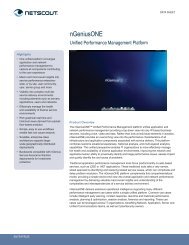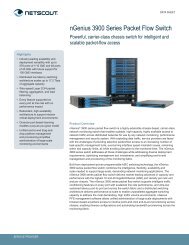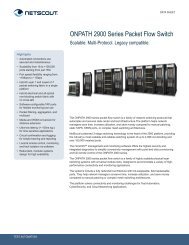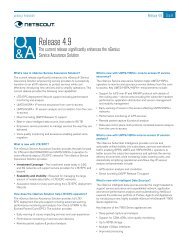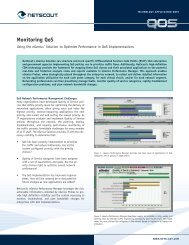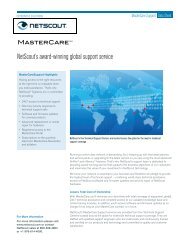to download the Conference Agenda - NetScout
to download the Conference Agenda - NetScout
to download the Conference Agenda - NetScout
You also want an ePaper? Increase the reach of your titles
YUMPU automatically turns print PDFs into web optimized ePapers that Google loves.
TUESDAY, NOVEMBER 2, 2010<br />
10:00 AM–12:00 PM<br />
Franciscan B<br />
TRA403a - Hands-on Training Lab<br />
nGenius InfiniStream Lab: “Back in <strong>the</strong> Packet”<br />
Brian Hendee<br />
Follow <strong>the</strong> packet from <strong>the</strong> inside out . The final answer is in <strong>the</strong> packets, just <strong>the</strong> one you need, when you<br />
need it . Our nGenius InfiniStream appliances, through its graphical user console, provides Packet-Flow<br />
visibility, from capture, <strong>to</strong> index, and filtering, and offers intelligent deep analysis as packets continuously<br />
cross <strong>the</strong> wire for s<strong>to</strong>rage and retrieval . Learn what packet analysis troubleshooting methods are best for<br />
what situations . In this hands-on lab, we’ll share best practices and tips <strong>to</strong> help determine <strong>the</strong> root cause<br />
of typical network problems . Investigate trace files <strong>to</strong> uncover and apply <strong>the</strong> most productive methods for<br />
troubleshooting . Learn how <strong>to</strong> compare <strong>the</strong> bad with <strong>the</strong> good, decipher each problem one step at a time,<br />
and set up effective filtering, one of <strong>the</strong> best ways <strong>to</strong> quickly isolate problems .<br />
10:00 AM–12:00 PM<br />
Franciscan A<br />
TRA405a - Hands-on Training Lab<br />
Service Provider Lab: “Wirelessly nGenius”<br />
Don Prefontaine<br />
Service Provider moni<strong>to</strong>ring and network analysis requires a 4G perspective . In addition <strong>to</strong> <strong>the</strong> traditional<br />
enterprise network 3G approach, consideration must also be given <strong>to</strong> <strong>the</strong> timing of <strong>the</strong> user traffic as<br />
its transits packet tunnels between <strong>the</strong> Radio Area Network and <strong>the</strong> provider network while on its way<br />
<strong>to</strong> <strong>the</strong> Provider or Internet resource . In this hands-on lab we’ll examine both bearer (user) and control<br />
traffic timing <strong>to</strong> determine if response times are reasonable or if <strong>the</strong>y have crossed <strong>the</strong> line . As wireless<br />
infrastructure nodes like PDSNs and SGSNs become loaded, <strong>the</strong>ir responsiveness may decline and so may<br />
<strong>the</strong> subscriber’s impression of network performance . Using <strong>the</strong> graphical features of <strong>the</strong> nGenius Service<br />
Assurance Solution, we will examine <strong>the</strong> good, <strong>the</strong> bad, and <strong>the</strong> ugly <strong>to</strong> help you recognize <strong>the</strong>se timing<br />
issues .<br />
11:00 AM–12:00 PM<br />
Imperial A<br />
BKE206 - Enterprise: Best Practices<br />
Reducing IP O<strong>the</strong>r: Moni<strong>to</strong>r More Known Applications in nGenius Performance<br />
Manager<br />
Brian Philips; Guest Speaker: Don Porter, Zions Bancorporation<br />
Identifying, <strong>the</strong>reby reducing IP_O<strong>the</strong>r Traffic on your network is a good practice for developing a baseline of<br />
your network’s typical behavior . This session will help you <strong>to</strong> more readily identify standard traffic on nonstandard<br />
ports and identify cus<strong>to</strong>m applications by identifying servers and operating systems . Tools and<br />
methods are included, including knowing how and when <strong>to</strong> know it is time for launching a few techniques <strong>to</strong><br />
reduce <strong>the</strong> IP_O<strong>the</strong>r traffic .<br />
11:00 AM–12:00 PM<br />
Imperial B<br />
BKE207a - Enterprise: Best Practices<br />
How Do You Know if You are Being Hacked?<br />
Fred Phillips<br />
Thinking your network is secure and knowing your network is secure are not <strong>the</strong> same things . Knowing<br />
requires onging assessment of your moni<strong>to</strong>ring techniques, whereas thinking is <strong>the</strong> belief that <strong>the</strong> last<br />
security patch was good enough <strong>to</strong> hold it <strong>to</strong>ge<strong>the</strong>r . Does thinking mean your network is safe? No, it just<br />
means you have not detected <strong>the</strong> latest hack against it . In this lecture / demo we will examine some of <strong>the</strong><br />
common network attacks and how nGenius your <strong>NetScout</strong> products are at recognizing <strong>the</strong>m . The techniques<br />
we’ll cover will get you thinking about how well you know your network, and <strong>the</strong> moni<strong>to</strong>ring practices you can<br />
put in place <strong>to</strong> make it more secure .<br />
13



